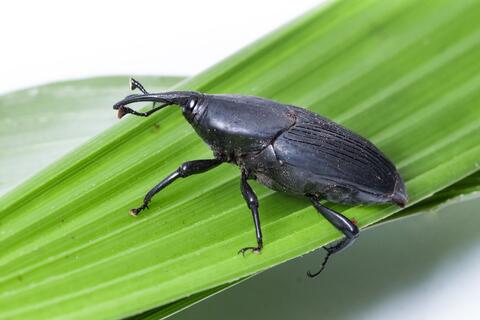The weapon involves a pheromone specific to the South American palm weevil, a type of beetle capable of flying more than 15 miles in one day. Pheromones are naturally occurring compounds that attract insects.

A new $1.1 million grant from the California Department of Pesticide Regulations is enabling project “Fatal Attraction,” which will test the pheromone in urban areas of San Diego County. Weevils there have killed more than 20,000 palms to date.
“Near Chula Vista there’s a road called Palm Avenue, but it’s all stumps and dead trees now, and the weevils are transforming the visual appeal of Old Town San Diego as well,” said Mark Hoddle, UCR entomologist and director of the Center for Invasive Species Research.
Hoddle warns that the weevils’ ability to produce very large populations is currently unchecked as there are no native natural predators that control this pest.
Consequently, homeowners and managers of parks, recreational, and business areas are relying heavily on protective applications of insecticides to the soil and palm foliage. These treatments are applied several times a year to protect palms from weevil attacks at a cost of several hundred dollars per treatment.

Feeding by weevil larvae in the crown of palm trees can result in the tree’s inability to produce new fronds and, eventually, the death of the entire tree.
“A weevil infestation is a death sentence for the palm. These insects have 100% kill rate in three to six months, unless the tree is treated very aggressively. Even treatment may not be enough to save an infected palm,” Hoddle said.
The treatment Hoddle’s team is testing represents a more environmentally friendly way to reduce weevil populations than the strategies currently being used.
“One of the only ways we’re currently able to kill them is by spraying 60-foot palm trees. It’s literally raining insecticide from high-pressure hoses,” Hoddle said.
Cities are also attempting to control the weevils by injecting the surrounding soil with insecticides, a strategy with undesirable off-target effects. “The insecticide they’re using belongs to a class of pesticides called neonicotinoids, which has been implicated in bee decline,” Hoddle said.
The pheromone is commercially available and sold by Iscatech, a Riverside-based company. It is mixed into a waxy matrix along with a very small amount of insecticide that only kills if the insect touches it. A dollop, the size of a quarter, can be applied to an inert object, such as a fence or lamp post.
The pheromone is species specific and is attractive to both male and female weevils.

“The weevil flies to it, walks over it several times, realizes there’s nothing in it to mate with and flies off. But by the time it’s gone, it’s gotten a lethal dose of insecticide,” Hoddle said.
The waxy matrix is made of a proprietary substance that releases the pheromone slowly, so that the treatment lasts for several months. Researchers predict that as they increase the number of dollops deployed in the infested test areas, weevil numbers will decline, and palm trees will begin to survive in higher numbers.
This approach could provide weevil control at much lower costs, as well as reducing the amount and types of insecticides applied.
If successful, the treatment would also prevent migration of the weevils toward the Coachella Valley, home to a $100 million date palm industry and only 93 miles from current infestations. Just a few “super flyers” could enable such an infestation, Hoddle said.
“The date growers in Coachella could really use this,” Hoddle said. “If it works in San Diego, we’ll have a tool ready for them.”